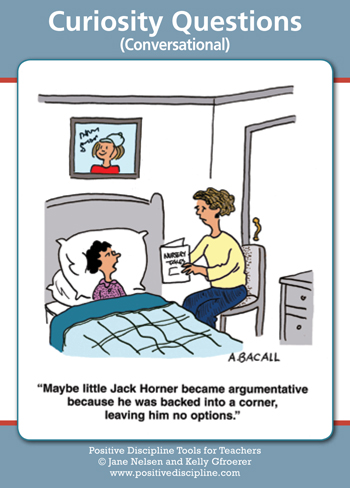by Kelly Gfroerer and Jane Nelsen
The root of education is educare—to draw forth.
1. Children will listen to you AFTER they feel listened to.
2. When children hear a command, a signal is sent to the brain that invites resistance. When children hear a respectful question, a signal is sent to the brain to search for an answer. In the process they feel capable and are more likely to cooperate.
3. Stop “telling” and “ask” curiosity questions (using your own words) such as:
- “What happened?”
- “How do you feel about it?”
- “How do you think others feel?”
- “What ideas do you have to solve this problem?”
4. See “Curiosity Questions Motivational.”
One of the most important skills that both models mutual respect and allows children to develop their perceptions of personal capability is open-ended questioning. This Positive Discipline Tool, Curiosity Questions, also helps develop “social feeling” because the child feels respectfully included.
Any statement you might like to make can be put in the form of a question. If you want to let children know you think they are being too noisy, ask, “How many think it is getting too noisy in here?” It is especially effective if you ask the question both ways. If you ask how many think it is okay, also ask how many think it is not okay. The less you let your own biases show, the more you invite children to think for themselves. It is amazing how often children come up with the same kind of lecturing and moralizing statements they reject when spoken by an adult.
Conversational curiosity questions take more time than motivational curiosity questions because you are doing more than inviting a the child to think of a solution to a simple task that requires attention, such as, “What do you need to do to get your work done on time?” Conversational curiosity questions require just what the name suggests: a conversation.
Asking questions with genuine curiosity can change an atmosphere from negative to positive. Below is an example.
A teacher requested a counselor to help with Stephen, a student who was causing a great deal of trouble on the playground. The counselor felt the best way to handle the problem was through a class meeting. This teacher had never held a class meeting, so the counselor used this opportunity to demonstrate.
She asked Stephen to leave the classroom go to the library. The general rule is that you do not discuss a child who is not there, but in this case she knew that a positive atmosphere had not been created and she did not want to take the chance that Stephen would be hurt by the comments. The class meeting was started by asking who the biggest troublemaker in the class was. The students all chorused, “Stephen.” They were then asked what kind of things Stephen did to cause trouble. They mentioned fighting, stealing balls, swearing, calling names, and so on. These first questions allow the children to express what they have been thinking and feeling.
The next questions allowed the children an opportunity to think more deeply. “Why do you think Stephen does these things?” The answers included such things as “Because he is mean.” “He is a bully.” Finally one student said, “Maybe it is because he doesn’t have any friends.” Another student chimed in with the information that Stephen was a foster child.
When the children were asked to discuss what it means to be a foster child, they offered such ideas as how hard it must be to leave your family, move so much, and so forth. They were now expressing understanding for Stephen, instead of hostility.
When asked, “How many of you would be willing to help Stephen?” every student in the class raised his or her hand. A list was made on the board of all their suggestions of what they could do to help. These included walking to and from school with Stephen, playing with him during recess, walking to school with him, eating lunch with him and about 10 other ideas. Specific volunteers were then listed after each suggestion.
Later, the counselor told Stephen that the class had discussed the problems he had been having on the playground. When he was asked if he had any idea how many of the students wanted to help him, he looked at the ground and replied, “Probably none of them.” When he was told that every one of the students wanted to help him, he looked up with wide eyes and asked as though he couldn’t believe it, “Every one?” It was obvious that Stephen felt very encouraged by this turn of events.
When the whole class decided to help Stephen, and followed through on their commitments, he felt such a sense of belonging that his behavior improved dramatically.


No Comments yet!